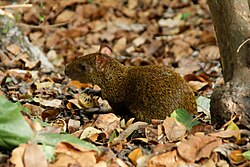Common Agouti
| Common agouti Temporal range: Recent |
|
|---|---|
 |
|
| A Central American agouti eating some fruit | |
| Scientific classification | |
| Kingdom: | Animalia |
| Phylum: | Chordata |
| Class: | Mammalia |
| Order: | Rodentia |
| Family: | Dasyproctidae |
| Genus: |
Dasyprocta Illiger, 1811 |
| Species | |
|
See text |
|
See text
The term agouti (Spanish: agutí, Spanish pronunciation: [aɣuˈti]) or common agouti designates several rodent species of the genus Dasyprocta. They are native to Middle America, northern and central South America, and the southern Lesser Antilles. Some species have also been introduced elsewhere in the West Indies. They are related to guinea pigs and look quite similar, but are larger and have longer legs. The species vary considerably in colour, being brown, reddish, dull orange, greyish or blackish, but typically with lighter underparts. Their bodies are covered with coarse hair which is raised when alarmed. They weigh 2.4–6 kg (5.3–13.2 lb) and are 40.5–76 cm (15.9–29.9 in) in length, with short, hairless tails.
Confusingly, the related pacas were placed by some authorities in a genus called Agouti, though Cuniculus has priority and is the correct term.
In Mexico, the agouti is called a sereque.
In Eastern Ecuador, the common agouti is known as guatusa.
Agoutis have five front and three hind toes; the first toe is very small. The tail is very short or nonexistent and hairless. The molar teeth have cylindrical crowns, with several islands and a single lateral fold of enamel. Agoutis may grow to be up to 60 cm (24 in) in length and 4 kg (8.8 lb) in weight. Most species are brown on their backs and whitish or buff on their bellies; the fur may have a glossy appearance and then glimmers in an orange colour. Reports differ as to whether they are diurnal or nocturnal animals.
In the wild, they are shy animals and flee from humans, while in captivity they may become trusting. In Trinidad, they are renowned for being very fast runners, able to keep hunting dogs occupied with chasing them for hours.
...
Wikipedia
